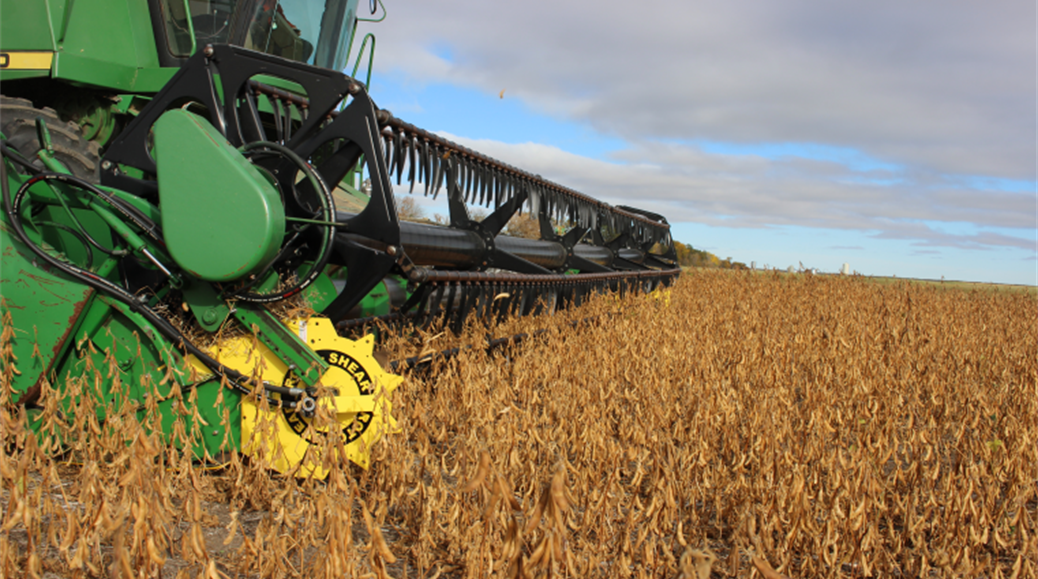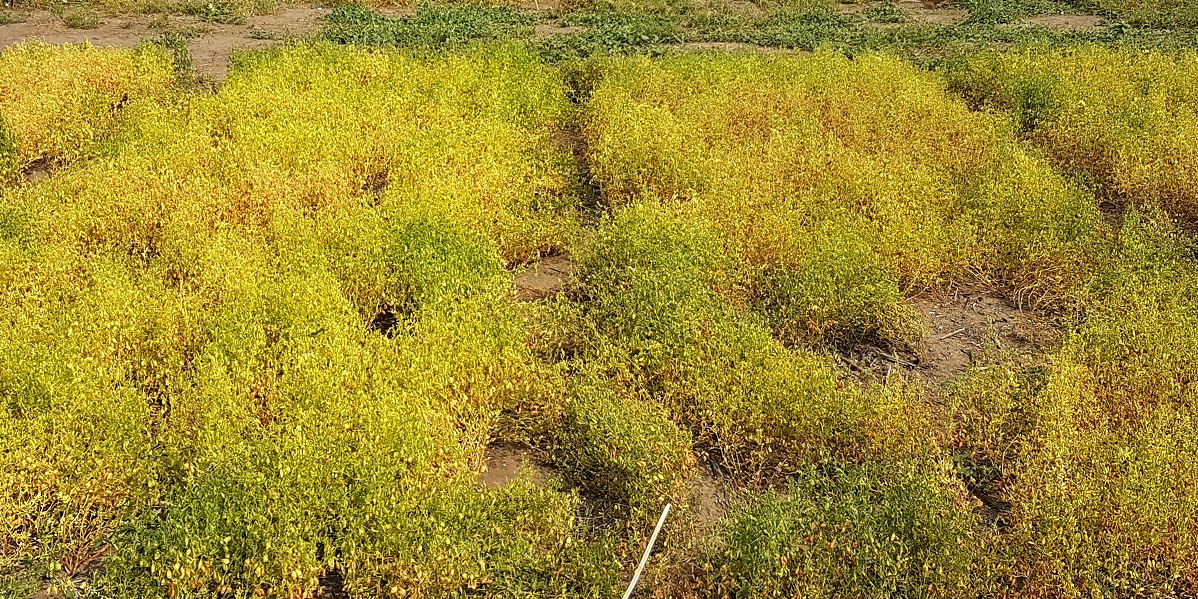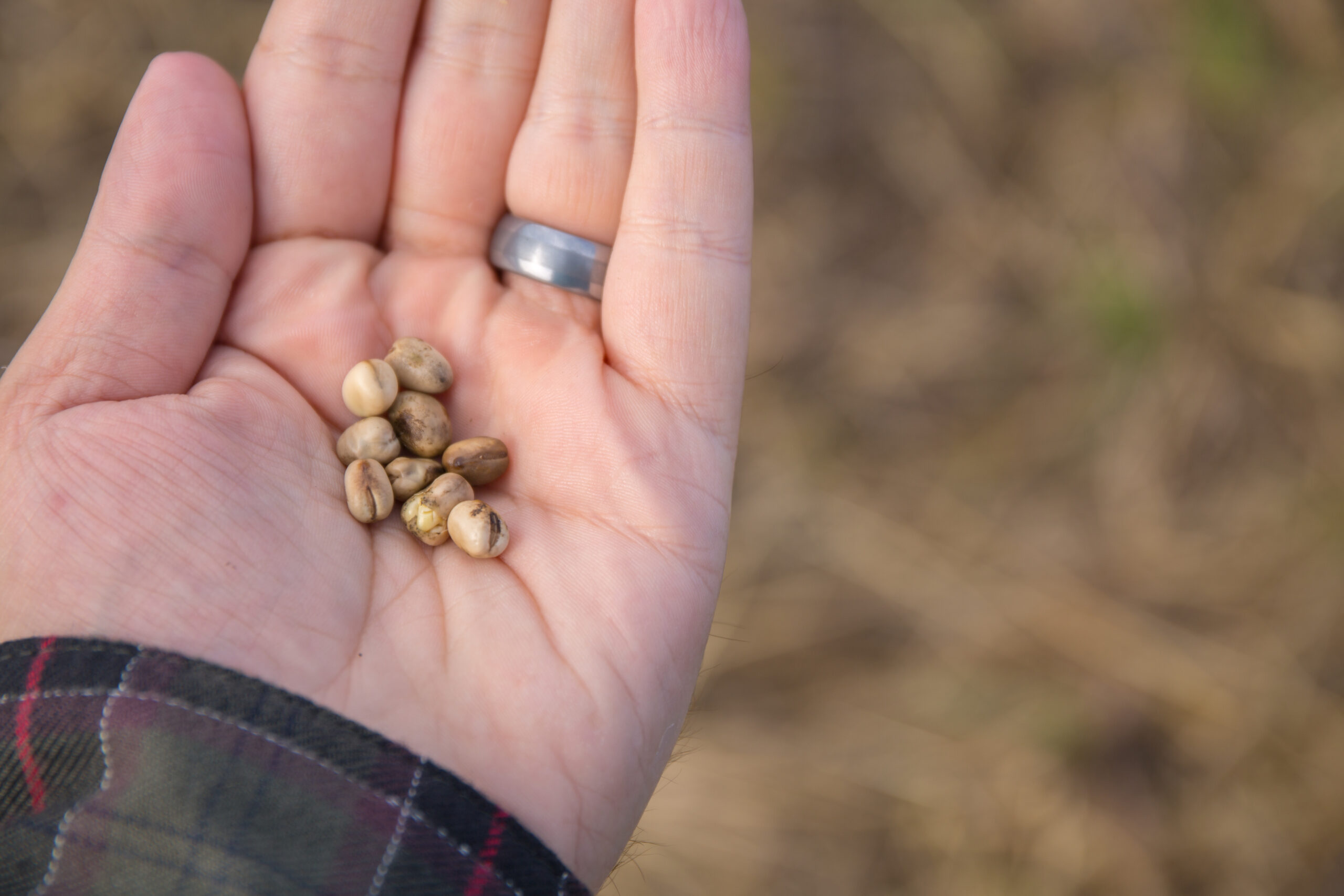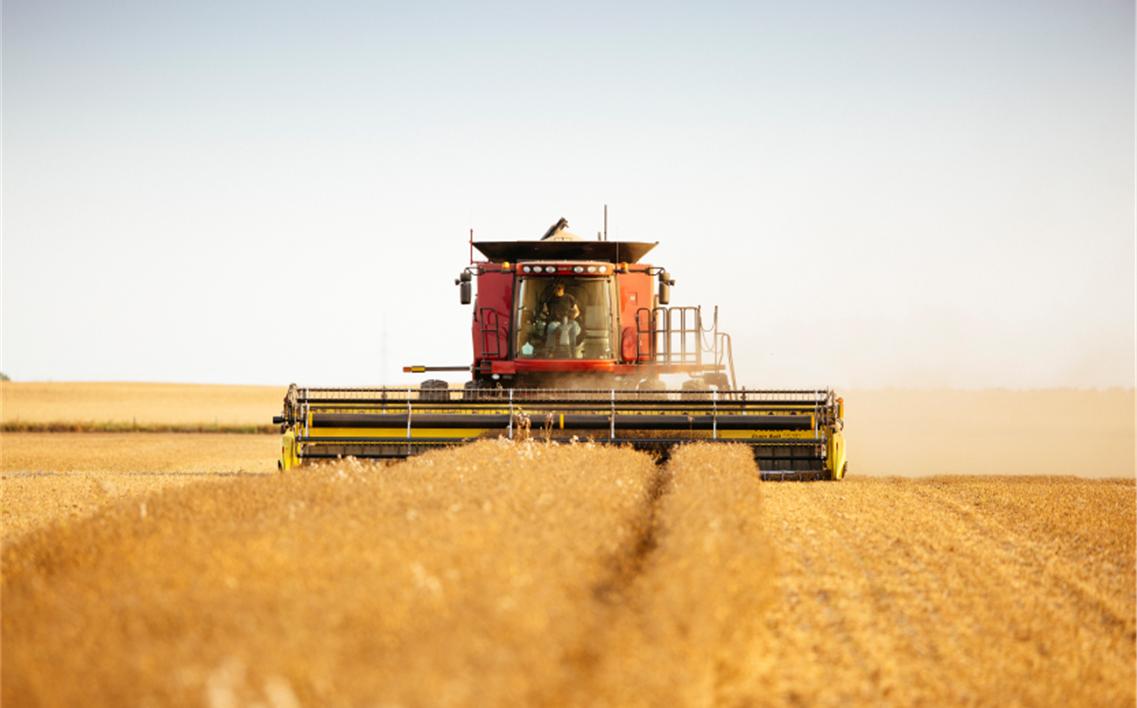By Bruce Barker, P.Ag.
You cannot manage what you do not measure is a common adage from the business world – and it applies to harvest losses. Joel McDonald, Program Manager with the Prairie Agriculture Machinery Institute (PAMI) says that while much more research on harvest losses has been conducted for wheat and canola, the same principles for managing harvest losses apply to pulses and soybeans.
Top Tips for Managing Harvest Losses
The use of a drop pan is recommended as combine loss monitors are not always accurate or properly calibrated. Several tools and websites are available to help calculate harvest losses.
- PAMI Combine Seed Loss Guide
- Saskatchewan Soil Conservation Association Harvest Loss Calculator
- Measuring Soybean Harvest Losses
Commercially-made drop pans can be purchased and installed on the combine. These pans can be remotely released by the operator and are the safest option. Growers can make their own by using flat pans with high sides, either attached to a stick for placement under the combine, or as a throw pan that is simply thrown under the combine as it passes by.
Disengage the spreader and straw chopper so that all material falls on the drop pan, and then separate the grain in the pan from other straw and material. Follow the instructions in the harvest loss guides or apps to determine seed loss.
An acceptable loss is relative to the price of the commodity, productivity, and a clean sample. In lower priced crops, a higher loss might be acceptable as a compromise to harvesting at a higher speed. For high value crops, going slower to reduce losses may be more important. Les Hill with PAMI (retired) indicated that canola losses, for example should be less than two per cent and hopefully one per cent as a general target.
More power, capacity, and driving faster to keep the combine full does not mean losses will be minimized. At some point, grain loss will climb exponentially as more material is fed into the combine (driving faster). Only marginally slowing down, perhaps 0.3 miles per hour, may result in a significant decrease in seed loss. Conversely, a small increase in speed may result in a high seed loss since the combine reaches a critical point where the loss curve rises steeply.
Start with your combine manual and use the suggested settings.
- If there are unthreshed pods in the chaff, the combine is underthreshing. Cylinder or rotor speed may need to be increased, the concave setting narrowed, or slowing down may be solutions.
- Overthreshing can be seen in cracked seed, which can also be a result of going too slow. In pulses where cracked seed can be a downgrading factor, a balance between overthreshing and seed loss should be considered.
- Adjust fan speed to the point where seed is just beginning to blow over. Open chaffer and sieve settings as wide as you can tolerate.
Conventional combines with walkers thresh and separate the grain best when a wider swath is fed evenly into the width of the cylinder and walkers. Rotary combines perform better with a narrow windrow.
Uneven windrows or feeding during straight cutting can result in higher losses. PAMI research found that when a windrow was concentrated down the middle of a conventional combine, losses were 7.5 per cent, rising to 12.3 per cent when the bulk was on one side of the combine. For a uniform crop fed evenly into the combine, losses were just 2.2 per cent. The reason is that for uneven feeding, air cannot move through the straw and grain is moved out the back of the combine.
While pulses and soybeans should be at a recommended moisture content for proper storage, harvesting can start at up to 20 per cent moisture content. Harvesting at higher moisture content can help to reduced seed damage and downgrading. Ensure grain is dried and conditioned to safe storage moisture content after harvest.
Most pulse and soybean growers use a flex header that can more closely follow the ground to straight cut low hanging pods. Both draper and auger type headers are common. Research from Iowa State University found that excessive stubble height resulted in increasing harvest loss.
Table 1. Soybean Seed Loss
| Height of Cut | % Loss |
|---|---|
| 0 inches (Hand cut) | 0% |
| 3.5 inches | 5.4% |
| 5.0 inches | 9.4% |
| 6.5 inches | 12.2% |
Source: Iowa State University
Pods that never make it into the combine can account for a large amount of harvest loss. These losses occur because of lost pods at the header, either shattering or left below the cutter height. Header losses can be minimized through good management practices such as proper field selection, crop rotation, and rolling fields to allow combine header to operate close to the ground.
Tips from Pioneer DuPont on reducing harvest loss in soybeans include:
- Be sure knife sections and ledger plates are sharp, and that wear plates, hold-down clips, and guards are properly adjusted. Chains and bearings should be properly lubricated, and belts tight.
- Proper reel speed in relation to ground speed will reduce gathering losses. Shatter increases if the reel turns too fast, and stalks may be dropped if the reel turns too slow. Use a reel speed about 25 per cent faster than ground speed.
- The reel axle should be 6-12 inches ahead of the sickle in most cases. Operate a bat reel just low enough to tip cut stalks onto the platform. The tips of the fingers on a pickup reel should clear the cutterbar by about two inches.
Change only one variable at a time, including speed. PAMI’s Combine Seed Loss Guide has solutions to commonly encountered problems with combine seed loss.
The following information from Saskatchewan Pulse Growers and the Saskatchewan Ministry of Agriculture outlines specific recommendations for pulses:
Lentils
The best time to combine lentils is around 18 per cent moisture content. If they are being harvested at the dry stage of 14 per cent, the risk of seed cracking, chipping, and peeling is increased. Combine equipment equipped with flex header, automatic height control, pick-up reel, or air reels and vine lifters are an asset. Careful handling of lentils is important to maintain quality, so using slower speeds with the combine and auger is recommended. Make sure when transferring grain through augers and into bins that it is not subjected to high speeds or lengthy falls.
Combine adjustment guidelines include:
- Low cylinder or rotor speed are required to prevent seed chipping and breaking but fast enough to prevent cylinder plugging; usually somewhere in the range of 250-500 revolutions per minute (rpm).
- The crop should thresh easily so concave settings can be wide to allow good threshing and separation with minimal seed damage.
- Start with chaffers set at 3/4 inch and cleaning sieves at 3/8 inch and adjust from there. Keep tailings to a minimum. Ensure grain and return elevators are not splitting the seed. Keep fan speed only high enough to produce a clean sample, as lentil seed can be blown out the back of the combine.
Peas
The best time to combine peas is at around 18-20 per cent moisture content to reduce the risk of seed cracking or peeling, and reduce shatter losses. Seed coats are also prone to damage if they are handled at high speeds. Using slower speeds with the combine and auger is recommended in order to reduce cracking of the seed coat.
When combining a swathed pea crop, match the pick-up speed to the ground speed of the combine. Keep the swath moving uniformly to match combine capacity to reduce seed damage and shatter losses. Low combine cylinder or rotor speeds are required to reduce seed cracking. Speeds of 300-600 rpm are normally used, depending on the moisture content of the pea sample. An initial concave setting of 0.6-1.5 centimetres (cm) clearance at the front and 1.2 cm at the rear is recommended. Combine and grain augers should be operated full and at low speeds to reduce cracking and splitting of seeds. General recommendations for settings include low cylinder speeds, ample concave clearance, and maximum wind velocity.
Chickpeas
The best time to combine chickpeas is around 18 per cent moisture content. Chickpeas must be handled carefully to prevent seed chipping and cracking, and to maintain quality – especially the larger seeded Kabuli types – so reducing combine speed is recommended. Combine settings for chickpeas should start with those used for dry peas. Wider concave settings may be required for the larger seed types and increased cylinder or rotor speed may be needed to remove the seed from the pod.
Avoid combining chickpeas that are wet or immature. When straight cutting, air or pick-up reels should reduce harvest loss compared to bat reels. Make sure when transferring grain through augers and into bins that it is not subjected to high speeds or lengthy falls.
Faba Beans
Combine when the moisture content of the seed is at 18-20 per cent. Combining in the early morning may reduce seed damage if the moisture content is lower than 18-20 per cent. Combines should be set with maximum concave clearance, high fan speed, and reduced cylinder or rotor speed (300-400 rpm). Augers should be operated at low speeds to avoid splitting. To reduce seed coat cracking, minimize drop distances when moving faba bean seed.
Soybeans
Combining can begin at 20 per cent moisture content. Seed damage is high when soybeans are harvested at less than 12 per cent moisture, and harvest losses can also be high under dry conditions (four beans per square foot represents a harvest loss of one bushel per acre (bu/ac)). Adjust the cutter bar to cut as low as possible, but still allow it to float on ground. Straw must be mature – otherwise too many pods remain unthreshed and in the sample.
A recent study by PAMI by Avery Simundsson, Project Leader at Portage la Prairie, MB found that speed has a significant effect on crop losses at the header, and that slowing down by just one mile per hour can result in substantial savings. The trials took place in 2016 near East Selkirk, MB and data was collected at combine ground speeds of two, three, four, and five mph. At two, three, and four mph, header losses were calculated at about 1.36 bu/ac but at five mph, the header losses nearly doubled, to 2.18 bu/ac. Assuming a soybean price of $10/bu, that means the difference between harvesting at four mph and five mph is $8.20/ac.
The critical speed may vary by field, combine or crop/environmental conditions, but there will always be a point of exponential jump in seed loss.
The PAMI study also found that about 80 per cent of losses occur at the header but adding an air reel reduced losses by more than half when compared to losses recorded using just an auger header and pick-up reel.



